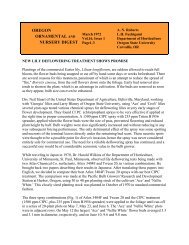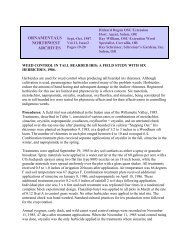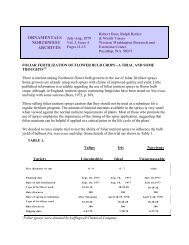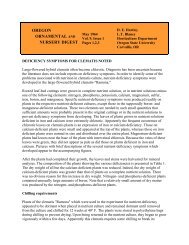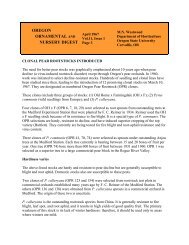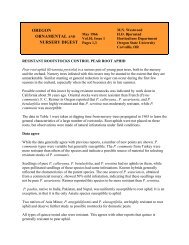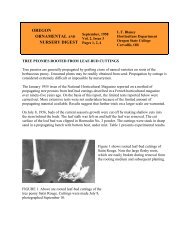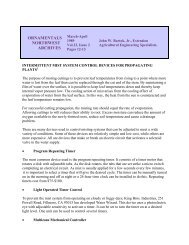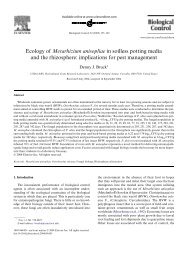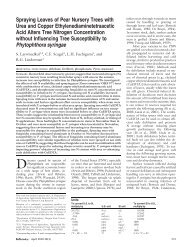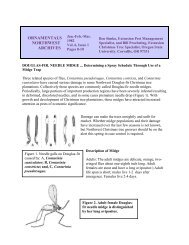Xylella Fastidiosa, A Newly Named Bacterium, Causes Leaf Scorch ...
Xylella Fastidiosa, A Newly Named Bacterium, Causes Leaf Scorch ...
Xylella Fastidiosa, A Newly Named Bacterium, Causes Leaf Scorch ...
You also want an ePaper? Increase the reach of your titles
YUMPU automatically turns print PDFs into web optimized ePapers that Google loves.
ORNAMENTALS<br />
NORTHWEST<br />
ARCHIVES<br />
May-June 1988<br />
Vol.12, Issue 3<br />
Pages 7-8<br />
Jim Green, Horticulture Extension Specialist<br />
Nursery and Greenhouse Crops<br />
Oregon State University,<br />
Corvallis, OR 97331<br />
<strong>Xylella</strong> fastidiosa, A NEWLY NAMED BACTERIUM, CAUSES LEAF SCORCH<br />
ON SEVERAL SHADE AND FRUIT TREES.<br />
A newly-named, single-species genus of bacteria, <strong>Xylella</strong> fastidiosa, that is closely related to<br />
Xanthomonas, causes leaf scorch symptoms on several shade and fruit trees (Wells, et al., 1987).<br />
The bacterium has been identified in American elm, American sycamore, red oak, red maple,<br />
mulberry, periwinkle, grape, almond, plum, peach and from ragweed. <strong>Xylella</strong> fastidiosa has been<br />
found in trees from New York to Georgia.<br />
Vectors: Several species of leafhopper have been found to be the insect vector of <strong>Xylella</strong><br />
fastidiosa for grapes and fruit trees. The insect vector for shade trees has not been identified.<br />
Symptoms: The first visible symptom of infection of the xylem by the bacteria is marginal leaf<br />
scorch followed by defoliation.<br />
Xyella symptoms are similar to those caused by drought.<br />
In infected sycamore, basal leaves show marginal and interveinal necrosis, whereas terminal<br />
leaves are unaffected (Sherald, et al., 1983).<br />
<strong>Scorch</strong>-affected red maple leaves showed undulating marginal necrotic areas of light and reddish<br />
brown tissue separated from green tissue by a chlorotic border. <strong>Leaf</strong> scorch may start out<br />
localized initially in individual branches and spread in succeeding years to additional branches.<br />
In the spring, leaves develop normally on previously affected branches; however, symptoms<br />
begin appearing in mid to late July and intensify as the summer progresses.<br />
<strong>Xylella</strong> symptoms appear in mid to late July<br />
<strong>Leaf</strong> discoloration, initially at the leaf margins, migrates with an undulating front toward the<br />
midrib and base of the leaf. Necrotic leaf tissue is composed of light brown areas frequently<br />
bordered by narrow to wide zones of dark reddish brown tissue. Necrotic tissue is separated from<br />
green tissue by a narrow, but distinct, chlorotic border.<br />
In late August, severely affected leaves abscise prematurely (Sherald, et al. 1987).
Leaves in all stages of symptom development occurred on the same branch of infected mulberry;<br />
severely affected leaves abscised prematurely and limited branch dieback was observed (Kostka,<br />
et al., 1986).<br />
Isolation: Strains of the bacteria associated with almond leaf scorch were isolated from infected<br />
leaf petioles; strains from plum leaf scorch and phony disease of peach were isolated from<br />
infected twigs and roots; ragweed strains were isolated from infected stems; elm, mulberry, and<br />
oak strains were isolated from chips of infected twigs. All strains grew on BCYE or PW medium<br />
but not on standard bacteriological media such as Trypticase soy agar, nutrient agar, or King B<br />
medium (Wells, et al., 1987)<br />
Sherald (1988) suggested using serological diagnosis to identify the bacterium. Agdia Inc, a<br />
private lab, has developed a serological diagnosis kit. The lab sells kits and also does diagnosis<br />
in-house (Agdia Inc., 1901 N. Cedar Street, Mishawaka, IN 46545, telephone 219/255-2817).<br />
Controls: None have been reported for this new disease. Oxytetracycline controlled the<br />
symptoms on peach trees, but symptoms returned when the treatment was discontinued (Sherald,<br />
1988).<br />
References:<br />
Kostka, SJ., T.A. Tattar, J.L. Sherald, S.S. Hurtt. 1986. Mulberry leaf scorch, new disease caused<br />
by a fastidious, xylem-inhabiting bacterium. Plant Disease 70:690-693.<br />
Sherald, J.L., S.S. Hearon, SJ. Kostka, and D.L. Morgan. 1983. Sycamore leaf scorch: Culture<br />
and pathogenicity of fastidious xylem-limited bacteria from scorch-affected trees. Plant Disease<br />
67:849-852.<br />
Sherald, J.L., J.M. Wells, S.S. Hurtt, and S.J. Kostka. 1987. Association of fastidious, xyleminhabiting<br />
bacteria with leaf scorch in red maple. Plant Disease 71:930-933.<br />
Sherald, James L. (Plant Pathologist, Center on Urban Ecology, National Park Service,<br />
Washington, D.C. 20242, telephone 202/342-1443). 1988. New <strong>Bacterium</strong> Identified as Cause of<br />
<strong>Scorch</strong> Symptoms. American Nurseryman 167(10):15, May 15, 1988.<br />
Wells, John M. (USDA, ARS, Plant Pathologist, Rutgers University, New Brunswick, NJ<br />
08903), Boligala C. Raju, Hsueh-Yun Hung, William G. Weisburg, Linda Mandelco-Paul, and<br />
Don J. Brenner. 1987. <strong>Xylella</strong> fastidiosa gen. nov., sp. nov: Gram-Negative, Xylem-Limited,<br />
Fastidious Plant Bacteria Related to Xanthomonas spp. International Journal of Systematic<br />
Bacteriology, Apr. 1987, vol. 37, No. 2, p. 136-143. §<br />
Pesticide Use - Due to constantly changing laws and regulations, no liability for the suggested use of chemicals in<br />
this Newsletter is assumed by the ONW Newsletter. Pesticides should be applied according to label directions on the<br />
pesticide container.
Permission to Reprint material appearing in the ONW Newsletter is granted with the request that you credit the<br />
source: Ornamentals Northwest Newsletter, date, volume, issue, page numbers. Do not excerpt or reprint in such a<br />
manner as to imply the author's endorsement or criticism of a product or concept.<br />
Nondiscrimination - The information in the Ornamentals Northwest Newsletter is provided with the understanding<br />
that no discrimination is intended and that listing of commercial products implies no endorsement by the authors.<br />
Criticism of products or equipment is neither intended nor implied.





